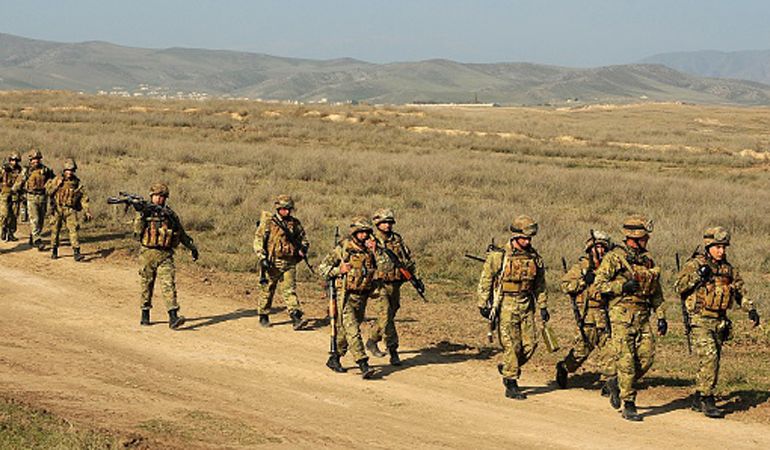The other Minsk mediation
Beyond eastern Ukraine, another simmering conflict threatens to erupt – Nagorno-Karabakh.

Amid the intense focus on the fragile ceasefire now in effect in eastern Ukraine, another simmering conflict, in a more remote part of Russia’s “near abroad”, is now dangerously close to erupting in renewed hostilities. That conflict, over Nagorno-Karabakh, an Armenian enclave that broke away from Azerbaijan over two decades ago, stands as the first “frozen” conflict within the former Soviet Union.
Like Ukraine, the Nagorno-Karabakh conflict involves a process of “Minsk mediation”, also through the Organization for Security and Co-operation in Europe (OSCE).
In the case of the Karabakh conflict, however, Minsk mediation is less about geography and more about geopolitics. The reference to Minsk is limited to a planned peace conference that was never held, and was set for Minsk merely because Belarus offered to host it, far back in the early 1990s. Based on that accident of history, the OSCE is engaged in diplomatic mediation through the so-called “Minsk Group”.
And beyond the geographical similarity, the geopolitical context is also as daunting, with a mediation effort led by the Minsk Group’s three co-chairing nations, France, Russia, and the United States.
Yet, this conflict is even more complex than Ukraine. Not only did the conflict erupt in the waning days of the Soviet Union, it is the only such conflict without any Russian presence. Russian pressure plays a part, especially as it is Moscow that now stands as the number one arms provider to all sides, but there are neither Russian citizens to “protect” nor Russian “peacekeepers” in Nagorno-Karabakh.
|
|
At the same time, the remote Karabakh conflict has also remained a pivotal consideration. That one small conflict has been the central obstacle to all regional development projects over the past quarter century.
It is this conflict that determined the route of the Baku-Ceyhan oil pipeline. It has also served as both the more serious impediment to “normalisation” between Turkey and Armenia, and the underlying driver of Armenian over-dependence on Russia as a security guarantor.
Nevertheless, the Karabakh conflict has remained manageably “frozen” for some time. Despite consistent skirmishes, an inherently fragile ceasefire has held since 1994. More remarkably, the ceasefire is fairly unique, as a self-enforced mechanism with no international enforcement and marginal supervision.
Yet, for these very same reasons, the ceasefire regime is inherently unstable, and dependent on the political will and calculation of the parties to the conflict alone. And over time, that political calculus has begun to change.
Azerbaijan's sense of frustration with diplomacy has driven it into a dangerous temptation to use the force of arms. And its attacks on Nagorno-Karabakh, and Armenia proper, are also messages to the mediators and the international community.
Azerbaijan, the larger and by far wealthier side, has initiated an “arms race”, marked by a surge in defence spending and weapons procurement. And as the peace process has dragged along, with no dividends or gains for Azerbaijan, the sense of frustration has only festered.
Now, Azerbaijan’s sense of frustration with diplomacy has driven it into a dangerous temptation to use the force of arms. And its attacks on Nagorno-Karabakh, and Armenia proper, are also messages to the mediators and the international community. It is this context that underlies and underlines Azerbaijan’s now public anger with the US, which it sees as having failed to pressure Armenia.
Energy assets
But for most western policymakers, Azerbaijan’s energy assets forgive many sins. And for all western capitals, the priority is clearly Ukraine, with both Armenia and Azerbaijan relegated to a secondary status as a subtext to the broader challenge of western relations with Russia. And without direct Russian presence, there has been a tendency to prioritise policy with little scrutiny and even less strategy towards this conflict.
Against this backdrop, then why the concern?
Clearly, unlike Ukraine, the Karabakh conflict is more remote and less of a reminder of any security threat to Europe. Yet, in recent months, there has been a steady surge in combat fatalities and a dangerous expansion of the conflict.
The first factor is demonstrated by the fact that violations of the Karabakh ceasefire are no longer measured in shots fired, but in deaths reported. The second factor is also seen in the emergence of a new battlespace, with attacks no longer limited to Nagorno-Karabakh, but now along the entire Armenian-Azerbaijani border.
And on a broader level, this now simmering “frozen” conflict poses an even greater challenge, nearly equal in severity to Ukraine. This challenge stems from the danger of escalation, whereby any renewed war will quickly draw in much larger, more powerful neighbouring states, including Russia, Turkey and even Iran, with each pursuing divergent interests.
Therefore, there is an imperative to look beyond Ukraine and to look again at an earlier round of Minsk mediation. Otherwise, there may be a fresh crisis emerging in another corner of the former Soviet space.
Richard Giragosian is the founding director of the Regional Studies Center, an independent think-tank in Yerevan, Armenia.
The views expressed in this article are the author’s own and do not necessarily reflect Al Jazeera’s editorial policy.
